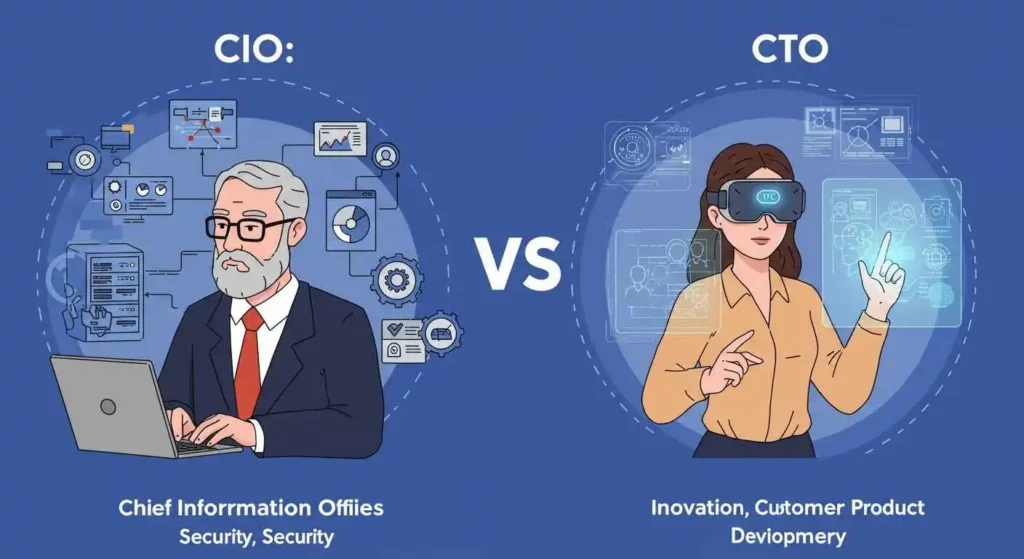Businesses rely on technology to keep up with the fast-paced digital world. Who is responsible for ensuring that the company’s tech strategy aligns with its goals? It usually comes down to the chief information officer vs chief technology officer.
While their titles might sound similar, the responsibilities they have are very different. Understanding the CIO vs. CTO discussion is crucial for both companies looking to grow and for tech professionals who want to take on leadership roles.
What is the role of a Chief Information Officer (CIO)?
A CIO is primarily concerned with how technology can support internal business operations. They are responsible for ensuring that systems such as ERP, CRM, and databases run smoothly. CIOs will seek better solutions if, for example, employees have trouble with old software that is slowing down their work.
Imagine the CIO is the person responsible for making sure that the “engine” of an organization runs smoothly. They ask:
-
Is the data secure?
-
Do employees have the right tools to do their jobs?
-
How can technology reduce costs and increase efficiency?
In many cases, CIOs are directly responsible to the Chief Executive Officer. This shows how important their role is for shaping business operations.
What is the role of a chief technology officer (CTO)?
A CTO, on the other hand, is more focused outward. They focus on innovations, customer experience, and new products. The CTO is typically in charge if a company wants a mobile application or to experiment with an AI-driven tool.
Imagine that a retail company is planning to develop a shopping app with personalized recommendations. The CTO makes sure the app is fast, user-friendly, and innovative to compete with competitors. Their vision helps drive growth and makes the company stand out in the market.
CIO vs CTO—A quick comparison
| Factor | CIO | CTO |
|---|---|---|
| Focus | Internal systems and efficiency | Innovation and product development by external sources |
| Goal | Support for daily operations | Create tech-driven growth |
| Reports | CEO or CFO | CEO (or CIO for smaller companies) |
| Key Concern | Compliance, security, and infrastructure | Customer experience and emerging technology |
Two leaders and an anecdote
A mid-sized online retailer faced a major challenge. Employees complained of slow systems, while customers wanted a more interactive application.
-
The CIO took action to upgrade servers, improve data security, and implement cloud tools. Productivity soared.
-
The CTO also led the development of an AI-powered app, which gave personalized recommendations to customers. In six months, sales doubled.
This story shows the complementarity between CIOs and CTOs. The CIO focuses on internal issues, while the CTO focuses on external ones. Both are important.
How to Balance the Roles of Business
-
Identify needs—is your company more concerned with internal inefficiency or innovation aimed at customers (CTO)?
-
Define Responsibilities—Avoid overlaps by defining the person who is responsible for infrastructure and innovation.
-
Encourage collaboration. CIOs and Chief Technology Officers (CTOs) should regularly meet to align their goals.
-
Training: Equip leaders with the most recent skills in AI and cybersecurity.
-
Measure impact—Track improvements in efficiency and customer satisfaction.
Understanding the Difference is Important
Many small business owners assume that they do not need both roles. As they grow, it becomes more important to have both a CIO and a CTO. Operations can be messy and unreliable without a CIO. Without a CTO, growth stagnates and customers leave.
According to research by Gartner, organizations that have a strong digital leadership position are more likely than their competitors to achieve higher revenue growth.
Final Thoughts
It’s not about the importance of each role, but about balance. The CTO is responsible for driving innovation and improving customer experience, while the CIO oversees the efficient operation of technology behind the scenes.
Both roles working in harmony are like having an engine with a powerful motor (CIO) and an intelligent GPS (CTO) for your business. The one who drives the car and the other who shows the route.

